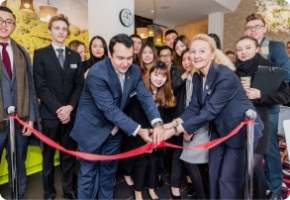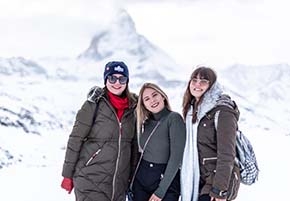- About
- Programs
- Campus Life
- Career Services
- Admissions
- News & Events
- Alumni
Can innovation save the ski industry?
Can innovation save the ski industry?
Climate change threatens the ski industry with rising temperatures and a shrinking winter season sending resorts around the world scrambling to find innovative solutions to save the world's favorite winter sport. Can ski resorts adapt in time to survive?
Imagine the thrill of embarking on a luxurious ski vacation at a majestic mountain resort, where adventure beckons with every snow-capped peak. Envision yourself gliding down pristine slopes, surrounded by powdery snow that shimmers like white gold in the sunlight. Downhill skiing offers a captivating fusion of adrenaline-pumping runs and serene mountain vistas. Yet, beneath its allure lies a profound and concerning challenge: Climate change threatens the landscape that defines these resorts.
As students of HIM in Switzerland, one of the world’s finest hospitality schools, elite skiing destinations are just a short train ride away. As climate change brings rising temperatures and a shrinking snow and ski season, can mountain resorts depend on skiing revenue anymore? Can they adapt to survive?
A Warming World
Do you remember in February 2024, when the temperature rose here in Montreux and it felt like spring? Scientists called it “the hottest first week of February ever.” While it felt lovely to take a stroll by the lake without a jacket, the shockingly warm weather forced some European ski resorts to close due to lack of snow.
The Alps, Europe's cherished mountain playground, face an uncertain future. With over 600 ski resorts, 10,000 ski-lifts, and more than 100 million annual visitors, this iconic region is a cornerstone of winter tourism. However, projections paint a grim picture: a potential 70% loss of snow cover by 2100 if global temperatures continue to rise at their current pace (the hottest year on record was 2023, and new temperature records have already been set in 2024). Glaciers in the Alps are expected to vanish almost completely by the end of the century. Lower-altitude resorts (below 2,000 m / 6,500 feet) are already struggling to produce enough snow to survive. Only the peaks of the alpine ski area might get enough natural snow by 2050.
The Alps will be nearly three times more impacted by global warming compared to the rest of the Northern hemisphere, but make no mistake: ski resorts globally are all under threat. In the US, the ski industry has lost an estimated $5 billion over the past two decades due to higher temperatures. By 2050, the ski season is projected to be reduced to 33 days.
“Average ski seasons in all US regional markets are projected to get shorter in the decades ahead under all emission futures,” said Daniel Scott, University of Waterloo scientist, speaking to The Guardian. “How much shorter depends on the ability of all countries to deliver on their Paris climate agreement emission reduction commitments and whether global warming temperatures are held below 2C (3.6F).”
How can ski resorts adapt and thrive in a world where snow is no longer a guaranteed guest? The first and most obvious answer is, of course, to make more snow. Nearly every global ski resort already depends on artificial snowmaking to survive. Snow machines create snow using water and pressurized air that atomizes, cools, and projects into the air as artifical snow out of “snow guns” situated all over a resort. An ingenious invention, but in a warming world, they rely on a conditions that may undermine the whole enterprise. Firstly, it needs to be cold enough for them to work, with the threshold being approximately 28 F, ideally lower. Secondly, they require water to operate, an increasingly scarce commodity in some mountain regions. Thirdly, pumping water and operating the snow machines requires expensive energy outputs, burning fossil fuels that only worsen the warming problem, while adding staggering energy expenditures to a resort’s bottom line.
The good news is that resorts are working to improve the efficiency of their snowmaking operations—with some achieving dramatic successes in reducing energy expenditure and water use. Investing in automated systems that are operated remotely is an innovation that enables ski resorts to operate the machinery more sparingly and take full advantage of brief temperature drops to maximize snow output.
Snow farming is another way that resorts are adapting to climate change, a method of preserving snow at the end of their season so that it is available for use at the start of the next season. Huge mounds of snow are kept under thick protective insulation and waterproof covering. At the Levi resort in Finland, this kind of snow farming is proving successful, with a melting rate of less than 13%, which means skiiers can look forward to an early start to the season with a solid base in place.
Resorts also move snow onto slopes with plowing machines or by dropping it from helicopters. Some resorts will trap wind-blown snow with a network of fences that redistribute the snow back to the slopes. In Switzerland, resorts are going even further with off-season snow farming, protecting endangered glaciers with heavy-duty insulation fabric to help reduce summer melting.
Every method to preserve snow and extend the ski season also increases costs and escalates energy use, which magnifies the overall warming problem. In a growing movement to improve sustainability in hospitality sector, forward-thinking resorts are going green, investing in renewable energy today to minimize their annual operating expenses, and reducing their carbon footprint to protect the white gold that their business depends on. Examples include solar-powered arrays, reducing water usage, retro-fitting night skiing with LED lighting, slowing down ski lifts, snow grooming machines that run on biofuels, and discounts for guests who arrive by train.
Promoting sports that require less snow is one way resorts are generating income.
A New Direction for Ski Resorts
With weather being such a volatile variable that influences guest behavior, creative ski resorts are adapting their pricing structures. The prices of single-day passes have risen sharply, while season-long passes are being priced at more attractive rates to encourage skiiers to spend before the season starts. In the US, walk-up ticket prices at large resorts have risen nearly six times the rate of inflation. Ski resorts are offering ticket add-ons to increase the overall customer revenue, including options such as “Fast Tracks” (no line at the ski-lifts), heli-skiing, and “First Tracks Early Access” (ski the first run of the day on fresh powder).
Some large ski resorts are expanding operations and purchasing multiple resorts spread out across different locations, meaning that even if one doesn’t have snow, it’s likely that some of them will. Vail Resorts in the US sells a season-long Epic Pass for less than US $1000 that gives skiers access to most of its 40 resorts across the US and in other countries. In France, Compagnie des Alpes links some of its resorts together so skiers can use the same pass for other properties. Beyond that, the company has diversified its holdings to include a chain of ski shops and year-round amusement parks to offset dependency on cold weather.
Summer use of ski lifts for hiking and mountain biking generates year-round income for ski resorts. Photo credit: Leysin Bike Park
Year-Round Mountain Tourism
Ski resorts are finding novel ways to reinvent themselves and remain relevant – and profitable – in a warming climate. Creative resorts are shifting the customer experience away from an exclusive focus on winter skiing toward year-round mountain activities. Nothing can singlehandedly replace the revenue of skiing, but offering a diverse range of activities can capitalize on a ski resort’s assets, at significantly less investment.
Some resorts offer winter sports attractions that don’t require as much snow, such as tobogganing and tubing runs for families. Many resorts are marketing themselves as mountain-biking and hiking destinations and investing in trail development, as well as being destinations for climbing, caving, and horseback riding. Some resorts are turning their properties into year-round adventure areas, with water parks, exhilarating zip-lines, and alpine coasters that speed you down the mountain on a track.
Beyond skiing adventures, mountains offer immense experiential benefits to tourists, with their stunning vistas, fresh air, natural wonders, and a respite from the hustle and bustle of the city. At France’s Morzine resort, they are leaning into mountain tourism, attracting guests to come and “walk with the eagles,” including high-altitude falconry shows and eagle-watching led by a local expert conservationist.
Unique experiences like this are on the rise. Gondola cabin “dates” have become a charming way to repurpose ski infrastructure when not in use. Imagine dining in a heated (or air-conditioned) gondola as it glides over alpine peaks, indulging in a fondue feast while taking in the breathtaking views.
Mountain resorts are also investing in cultural attractions that bring in new visitors year-round to their beautiful surroundings. In France, Compagnie du Mont-Blanc is building a high-altitude museum overlooking France’s largest glacier that will help visitors understand the impact of climate change. In 2023, the French resort Les Gets hosted the first Montreux Comedy Goes Skiing event; other resorts are hosting successful music festivals and art galleries as well.
Ski resorts are under threat but with hundreds of millions of avid skiiers hitting the slopes each year, the industry will not slip away quietly. As a student at HIM, learning how ski resorts are adapting is an enriching opportunity to observe how hospitality businesses need to embrace change in a crisis in order to survive, or else be left behind. The ski resorts of tomorrow are not just about skiing; they are about unforgettable customer experiences in a place with unparalled natural beauty. At HIM, you have the opportunity to learn from these creative strategies and contribute to a more sustainable and vibrant tourism economy.
Be world ready. Join the faculty, students, and alumni at HIM in being ahead of the curve in innovative business solutions. Learn how, download our brochure.
#Industry News













